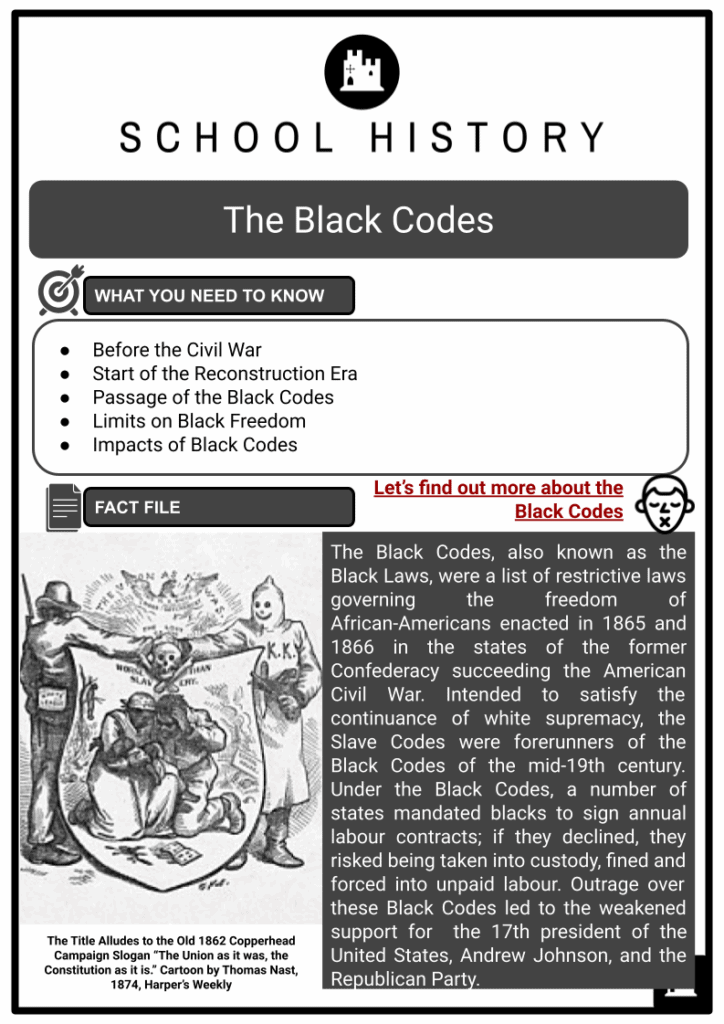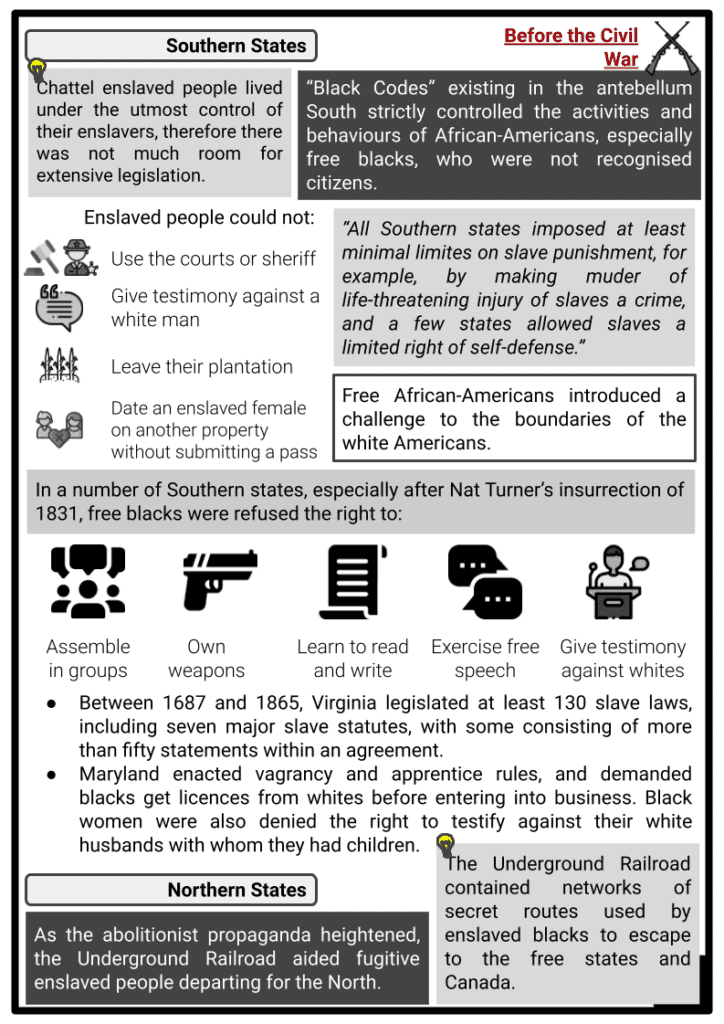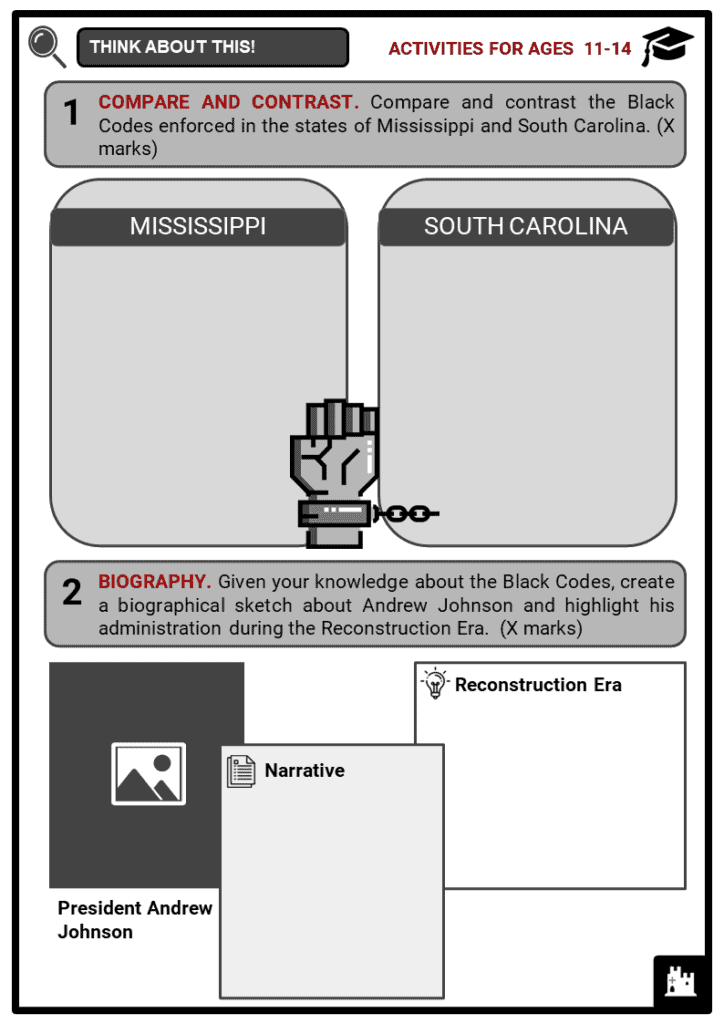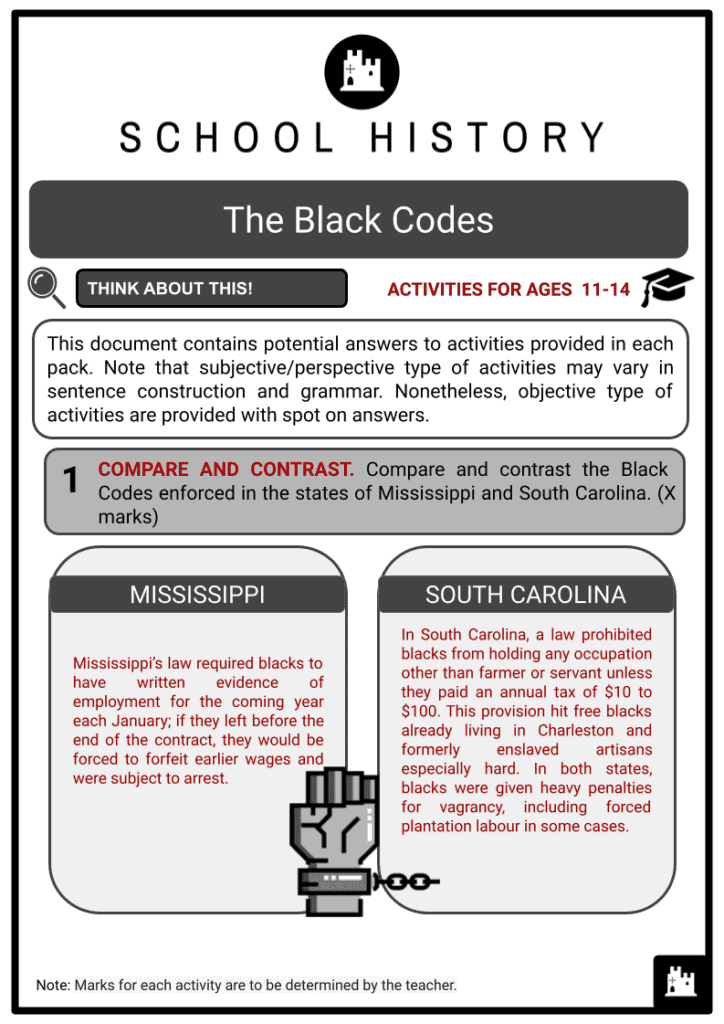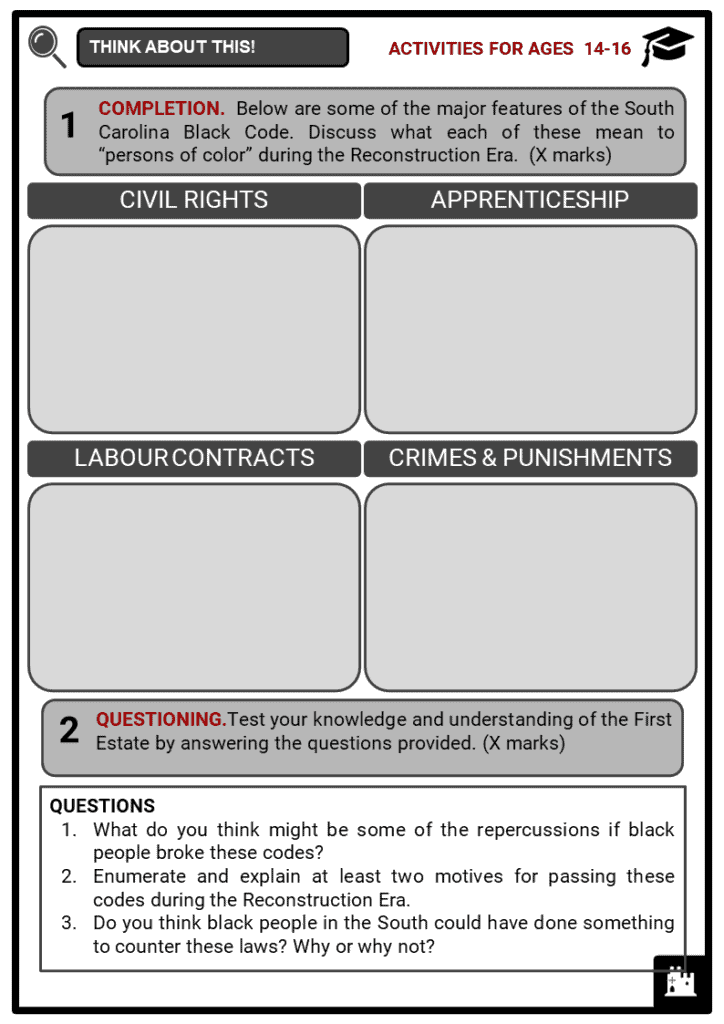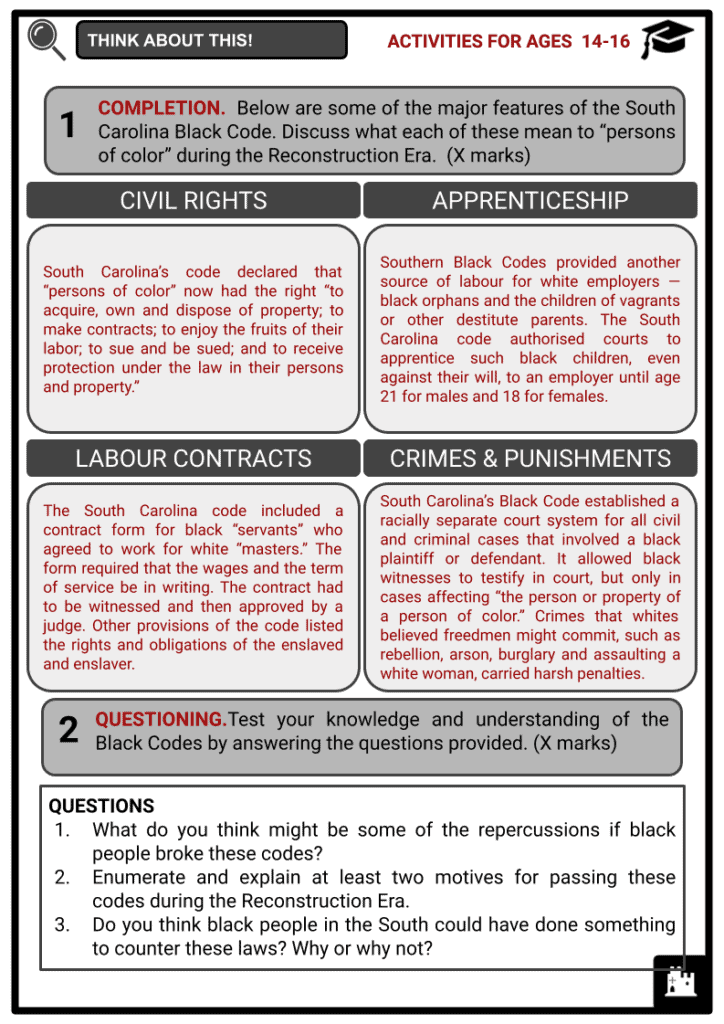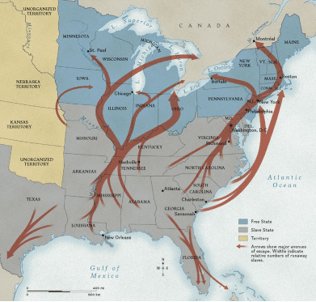Download The Black Codes Worksheets
Do you want to save dozens of hours in time? Get your evenings and weekends back? Be able to teach The Black Codes to your students?
Our worksheet bundle includes a fact file and printable worksheets and student activities. Perfect for both the classroom and homeschooling!
Table of Contents
Add a header to begin generating the table of contents
Summary
- Before the Civil War
- Start of the Reconstruction Era
- Passage of the Black Codes
- Limits on Black Freedom
- Impacts of the Black Codes
Key Facts And Information
Let’s find out more about the Black Codes
- The Black Codes, also known as the Black Laws, were a list of restrictive laws governing the freedom of African-Americans enacted in 1865 and 1866 in the states of the former Confederacy succeeding the American Civil War. Intended to satisfy the continuance of white supremacy, the Slave Codes were forerunners of the Black Codes of the mid-19th century. Under the Black Codes, a number of states mandated blacks to sign annual labour contracts; if they declined, they risked being taken into custody, fined and forced into unpaid labour. Outrage over these Black Codes led to the weakened support for the 17th president of the United States, Andrew Johnson, and the Republican Party.
Before the Civil War
Southern States
- Chattel enslaved people lived under the utmost control of their enslavers, therefore there was not much room for extensive legislation.
- “Black Codes” existing in the antebellum South strictly controlled the activities and behaviours of African-Americans, especially free blacks, who were not recognised citizens.
- Enslaved people could not:
- Use the courts or sheriff
- Give testimony against a white man
- Leave their plantation
- Date an enslaved female on another property without submitting a pass
- “All Southern states imposed at least minimal limites on slave punishment, for example, by making muder of life-threatening injury of slaves a crime, and a few states allowed slaves a limited right of self-defense.”
- Free African-Americans introduced a challenge to the boundaries of the white Americans.
- Between 1687 and 1865, Virginia legislated at least 130 slave laws, including seven major slave statutes, with some consisting of more than fifty statements within an agreement.
- Maryland enacted vagrancy and apprentice rules, and demanded blacks get licences from whites before entering into business. Black women were also denied the right to testify against their white husbands with whom they had children.
Northern States
- As the abolitionist propaganda heightened, the Underground Railroad aided fugitive enslaved people departing for the North.
- The Underground Railroad contained networks of secret routes used by enslaved blacks to escape to the free states and Canada.
- Territories and states close to the slave states did not acknowledge free blacks.
- In Oregon, blacks were not allowed to establish homes, marry or sign contracts.
- Ohio, Indiana and Illinois had common borders with slave states spanning across the Ohio and Mississippi rivers, even in Kentucky, Missouri and Virginia.
- The 1848 Constitution of Illinois approved one of the harshest Black Codes in the United States before the Civil War. The Illinois Black Code of 1853 restricted any African-American from outside the state from residing in the state for at least 10 days, subjecting violators to the rule of arrest, detention, a $50 fine, or deportation.
Start of the Reconstruction Era
- On 1 January, 1863, President Abraham Lincoln passed the preliminary Emancipation Proclamation, declaring the freedom of all the enslaved people from states under rebellion in the United States.
- The Reconstruction Era (1863 - 1877) is a significant chapter in the history of American civil rights.
- After announcing the Emancipation Proclamation, the stakes of the Civil War greatly drifted. A Union victory would suggest no less than an upheaval in the South, where the odd institution of slavery had monopolised economic, political and social life before the American Civil War.
- In 1865, as the bloodshed drew close, Lincoln startled the citizens by urging restricted suffrage for blacks in the South.
- Days later, he was assassinated and Vice President Andrew Johnson took over.
- “Jim Crow laws”, similar to the Black Codes, were established after the Reconstruction but were abolished with the Civil Rights Act of 1964.
- The 17th U.S. President Johnson, a former senator from Tennessee who showed great devotion to the Union during the Civil War, was a firm advocate of states’ rights and upheld the indifference of the federal government towards societal issues such as voting requirements at the state level.
- Under his Reconstruction rules, which started in May 1865, the previous Confederate states needed to:
- Support the elimination of slavery
- Swear loyalty to the Union
- Pay off their war debt
- The states and their ruling class, which were traditionally governed by white planters, were given a free hand in reconstructing their own administrations.
Passage of the Black Codes
- Even enslaved people fought to affirm their independence and obtain economic autonomy during the first years of the Reconstruction, white landowners sought ways to take charge of the labour force through a schematic resembling the Slave Codes. In late 1865, Mississippi and South Carolina legislated the first Black Codes.
- Slave Codes were laws to control slavery and enslaved people in the United States.
Mississippi
- Mississippi Black Codes ordered blacks to have written proof of work for the coming year every January; if they left before their contract expired, they would be obliged to forfeit earlier wages and be taken into custody.
South Carolina
- Just like the Mississippi Black Codes, South Carolina laws also included civil rights, labour contracts, vagrant laws, apprenticeship laws and penal laws. Blacks were limited to work as farmers or servants unless they could pay a yearly tax of $10 to $100.
Limits on Black Freedom
- Under Andrew Johnson’s Reconstruction prohibitions, almost all Southern states would enforce their own black codes in 1865 and 1866. While these laws acknowledged specific freedoms to black people, such as the right to buy and own property, marry, sign contracts and testify in court in cases involving people of their own race, the fundamental purpose was to reduce and limit the labour and activity of African-Americans.
- A “Colored People’s Convention” was held at Zion Church in Charleston, South Carolina to denounce and condemn these Black Codes.
- Some states restricted the type of property that black people could buy and own, while virtually all the previous Confederate states signed severe vagrancy and labour contract laws, including the “anti-enticement” guidelines made to penalise anyone who gave higher wages to an African-American labourer already under contract.
- Black Americans who breached their work contracts were arrested, beaten and forced into labour, and apprenticeship laws enforced a lot of minors, either orphans or those whose parents were considered helpless by the court in supporting their children, into unpaid labour for white employers.
- Ratified by a political system in which people of colour were not allowed to speak up, the Black Codes were imposed by all-white police and state militia troops, often composed of Confederate veterans of the Civil War, across Southern states.
Impact of Black Codes
- The restrictive nature of the Black Codes and the extensive black resistance to their implementation angered and provoked a number of citizens in the North, who argued that these laws violated the building blocks of the free labour concept.
- In 1870, the 15th Amendment assured each citizen’s right to vote, regardless of race, colour or former condition of servitude.
- White southerners showed their stubborn commitment to guaranteeing their supremacy.
- Discrimination continued with the rise of the Jim Crow laws, but triggered the ideas of the Civil Rights Movement in the years to come.
- The Reconstruction Act of 1867 ordered Southern states to sign the 14th Amendment, granting “equal protection” to enslaved citizens and universal male suffrage before rejoining the Union.
Image sources:

